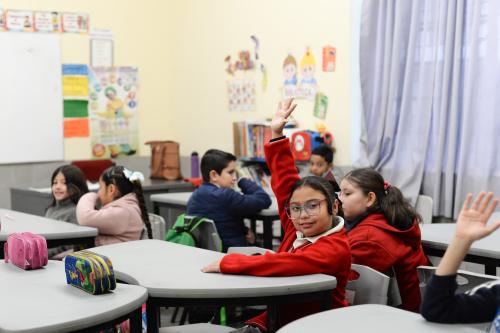EXECUTIVE SUMMARY
Americans want more media coverage of their local schools. In particular, they want more information than they now receive about teacher performance, student academic achievement, crime, and violence in their schools – and more as well about curricula, finances and reform efforts. While there is a great interest in receiving this information through new technological sources more so than ever before (http://pewresearch.org/pubs/1924/state-of-the-news-media-2011), Americans however, continue to rely on traditional media, particularly newspapers, for information on their schools. There is an imperative to improve both education journalism and the ways in which schools communicate directly to parents, students, and citizens.
In an earlier report (West, Whitehurst, and Dionne, 2009), we noted several problems with the way the media system reports on education, the most basic being that there little national coverage of education. During 2009, only 1.4 percent of national news coverage from television, newspapers, news Web sites, and radio dealt with education. In our content analysis, we found this paucity of coverage was not unique to 2009. In 2008, only 0.7 percent of national news coverage involved education, while 1.0 percent did so in 2007.
Of the education news that is reported, little relates to school policies and ways to improve the curriculum or learning processes. There was hardly any coverage of school reform, teacher quality, or other matters thought to be crucial for educational attainment. Instead, most 2009 stories focused on budget problems, school crime, and the H1N1 flu outbreak. The lack of news coverage of the actual work of schools represents a significant problem for the education area.
In a follow-up paper, we reported on interviews with a number of educational and media leaders, outlined new trends in education coverage, and described how major news organizations are re-imagining their futures (West, Whitehurst, and Dionne, 2010). We examined the development of niche publications, news aggregators, social media, and new content providers, and the emergence of alternative business models for funding news organizations. We also argued that education journalism is transforming itself into a new digital form that looks and behaves differently than traditional models. Digital technologies have altered the manner in which the traditional education news industry produces and disseminates information (Melton, 2009). Through the emergence of the Internet, social media, blogs, electronic news readers, smart phones, and cell phone texting, the cost of information transmission has dropped and the vehicles for communication have expanded dramatically. New content providers have found novel ways of delivering information to students, parents, and the general public.
The new ecosystem has clear strengths, including immediacy, interactivity, and diversity. But these virtues must be linked more effectively to the delivery of in-depth and substantive reporting. It is important to build on the strengths of new media platforms, but we also must find ways to develop high-quality coverage because it is crucial for democratic governance.
With the evolving mix of old and new media, how do Americans get information about elementary and secondary schools? How do they rate the performance of various content providers? What topics deserve additional attention? How would viewers and readers like to get information about schools in the future? And how do consumer differences in age, gender, race, income, region, and parental status affect their views about these issues?
In this report, we present the results of a national public opinion survey on education news. From December 6 to 19, 2010, we conducted telephone interviews with 1,211 adults aged 18 years or older (including an over-sample of parents) in the continental United States. We asked a series of questions about their education news consumption focusing on where respondents got their information, how they assessed media sources, and how they envisioned the future of education reporting and school communication. (See Appendix for description of survey methodology and questions.)
Respondents were clear on their priorities. Asked about the areas in which they wanted more coverage of their local schools, 73 percent wanted more information on teacher performance; 71 percent wanted more on student academic performance; 69 percent wanted more reporting on school crime or violence; 68 percent wanted more on school curricula; and 66 percent more both on school finances and school reform (66 percent). The matters about which respondents were least likely to seek more information were school athletic team performance (42 percent), and scandals or undesirable activities at their local schools (50 percent). The relatively smaller number of respondents seeking more coverage for school sports teams may not be surprising, since in many communities, athletics - particularly at the high school level - already receive substantial coverage.
The survey also asked respondents where they received education information now and how they would like to receive it the future. The most common sources of current education news were family and friends (75 percent), followed by daily newspapers (60 percent), school publications (56 percent), local television (54 percent), community groups (42 percent), national television (38 percent), Internet sites (37 percent), radio (33 percent), school specialty publications (28 percent), school Facebook or MySpace sites (14 percent), electronic newsreaders (11 percent), cellphone texts (nine percent), and blogs (nine percent). However, there were interesting age differences with young people being more likely than older people to rely on a range of Internet and electronic sources such as blogs, social media, electronic news readers, and cellphone texts.
The most highly regarded current news-providers were family and friends, with 62 percent rating that source positively. This was followed by school publications (45 percent), daily newspapers (44 percent), local television (38 percent), community groups (32 percent), school specialty publications (28 percent), Internet sites (25 percent), national television (24 percent), radio (24 percent), school Facebook sites (12 percent), electronic news readers (nine percent), blogs (nine percent), and cellphone texts (seven percent).
Young people were more likely than older respondents to have positive assessments of electronic outlets: 35 percent of those aged 18 to 29 gave excellent or good ratings to Internet news sites, compared to 9 percent of senior citizens. There were similar magnitudes of difference when it came to school Facebook sites (21 percent of the young but only four percent of older respondents have them positive ratings), blogs (11 percent positive from young people and five percent among those 65 years or older), electronic news readers (13 percent among the young, four percent among older respondents), and cell phone texts (10 percent versus two percent). Whites (46 percent) were more likely than non-whites (38 percent) to feel that newspaper coverage was excellent or good.
There were variations in respondents’ assessments of the overall quantity of the education news they received. Thirty-nine percent said they received too little information about elementary and secondary schools, 56 percent got “the right amount of information,” and only two percent said there was too much information. When asked about changes over time, 22 percent felt the quantity of news had increased, 60 percent felt it had stayed about the same, 10 percent believed that it had decreased. Thirty percent considered themselves well-informed about elementary and secondary schools in the community, 47 percent moderately informed, and 22 percent said they were poorly-informed.
When given a list of suggestions for improving the information they received on education information, 82 percent said their schools should communicate more though printed newsletters; 74 percent wanted to receive more school information through the Internet; and 71 percent wanted more from email communications. A noticeably large proportion, 67 percent, said they wanted to get more information through newspaper blogs and forums. The least popular areas for an expanded flow of education information were schools communication through Facebook pages (38 percent), through cell phone texts (32 percent) and cellphone texts from newspapers (23 percent).
Younger respondents were more interested in the newer technological approaches. Among younger respondents, 76 percent were interested in seeing schools communicate through the Internet, compared with 52 percent of older respondents. There were similar findings for newspaper blogs and forums (63 percent for the young, 42 percent for older respondents; school emails (80 versus 49 percent); cellphone texts (44 versus 22 percent); school Facebook pages (51 versus 30 percent); newspaper text alerts (70 versus 42 percent); newspaper cellphone texts (37 versus 18 percent), and newspaper blogs or forums (74 versus 56 percent). Non-whites were more interested than whites in expanded school communication through cellphone texts (42 for non-whites compared with 30 percent for whites), through Facebook (46 versus 35 percent), email alerts (65 versus 52 percent) and cellphone messages (40 versus 18 percent).
The Brookings Institution is committed to quality, independence, and impact.
We are supported by a diverse array of funders. In line with our values and policies, each Brookings publication represents the sole views of its author(s).





